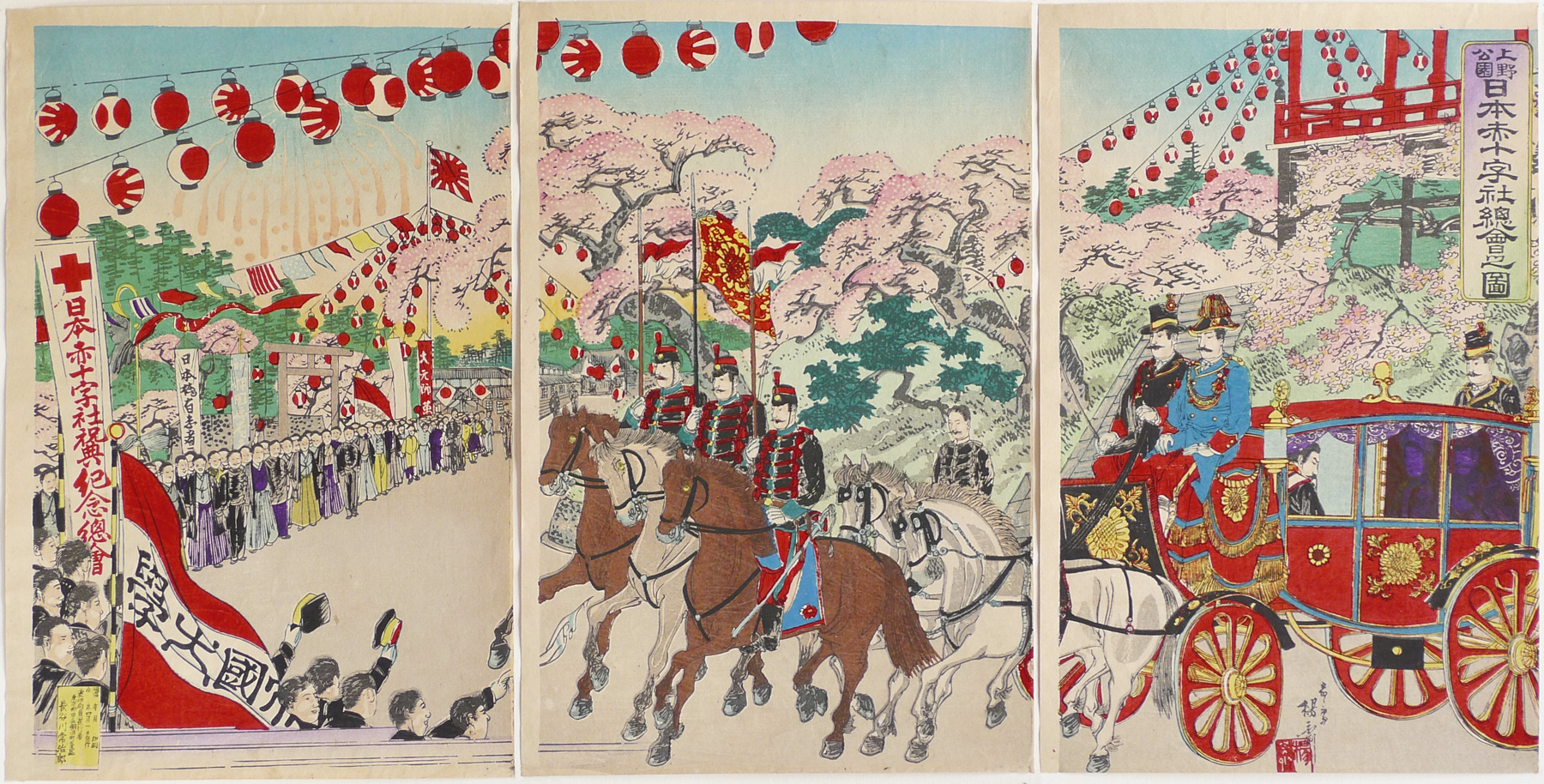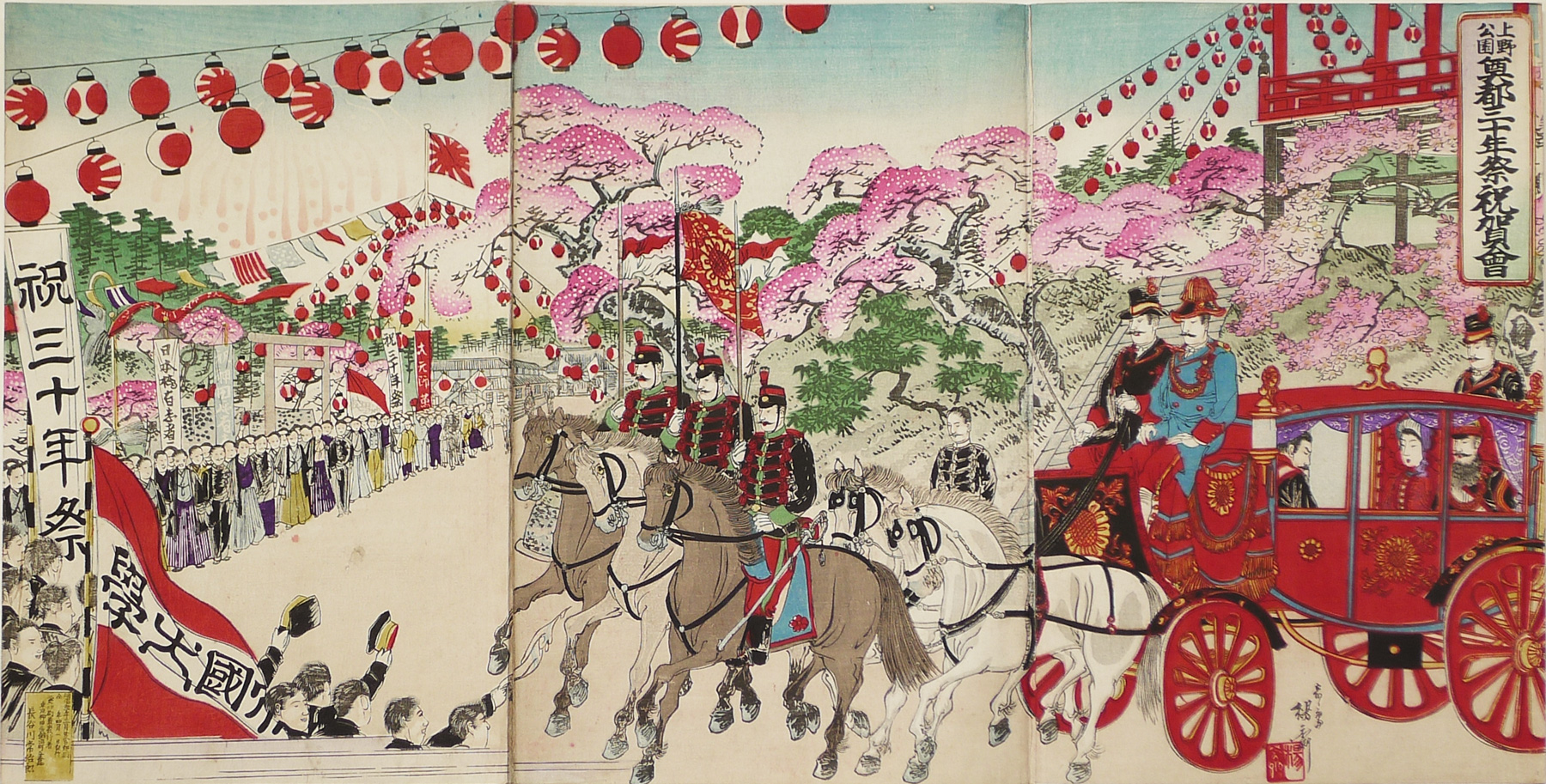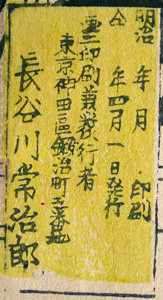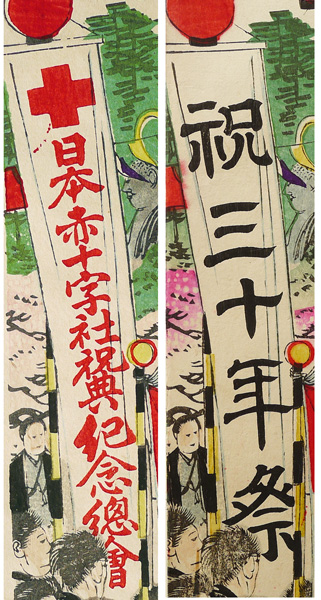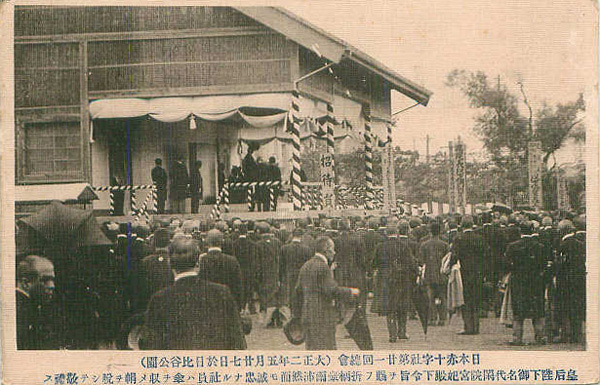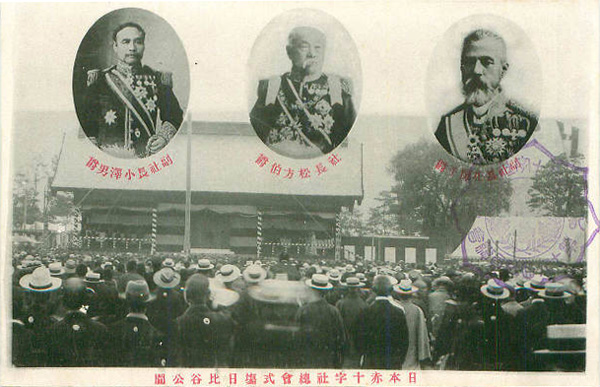Japanese Color Woodblock PrintUeno Park, Illustration of the Japanese Red Cross Society General Meetingby Nobukazu Watanabe, date unknown |
Japanese Color Woodblock Print
Ueno Park, Congratulatory Celebration for the
Thirty-year Festival of the Capital City
by Nobukazu Watanabe, 1899
IHL Cat. #901About These Prints
Being high volume commercial enterprises with small profit margins, Meiji-era publishers reused, on occasion, existing woodblock designs to illustrate different events. In the case of the above almost identical prints, picturing Emperor Meiji, Empress Shōken and, possibly, the governor of Tokyo arriving via royal carriage at a celebration in Ueno Park, one was issued in 1899 to commemorate the thirtieth anniversary of moving the capital of Japan from Kyoto to Tokyo and the other was issued in celebration of an annual meeting (the year of which is uncertain) of the Japanese Red Cross Society.
A comparison of the two prints, as shown below, reveals different title cartouches (as one would expect), differences within the publisher seal, differences in two of the banners on the left panel and, most strikingly, the overprinting in purple of the likenesses of the emperor and empress on the print commemorating an annual meeting of the Japanese Red Cross Society.
For more prints displaying the comings and goings of the royal couple see the article Prints of the Emperor Meiji and Empress Haruko.
title cartouche
Ueno Park
Illustration of the Japanese Red Cross Society General Meeting
上野公園
日本赤十字社總會之図Ueno Park
Thirty-year Festival of the Capital City
上野公園
園奠都三十年祭祝賀會publisher seal of Hasegawa Tsunejirō
Note that the date (year 年, month 月, day 日) of printing (印刷), shown in rightmost column, is left blank and the date of issuance (交付) in the column to the left of the printing date is given as 4th month, 1st day, as in the publisher's seal shown to the right.Thirty-year Festival of the Capital City
Note the printing (印刷) date of Meiji 32 (1899), 3rd month, 23rd day in the rightmost column and, to its left, the date of issuance (交付) of Meiji 32, 4th month, 1st day.
emperor and empress Japanese Red Cross Society General Meeting
Why are the emperor and empress veiled with this overprinting?emperor and empress Thirty-year Festival of the Capital City
Japanese Red Cross Society General Meeting
white banner is blank.
red banner reads:
"commander-in-chief ?"
大元帥?Thirty-year Festival of the Capital City
white banner reads:
"festival celebrating 30 years"
祝三十年祭
Japanese Red Cross Society General Meeting
"Japanese Red Cross Society..."
日本赤十字社...Thirty-year Festival of the Capital City
"festival celebrating 30 years"
祝三十年祭
The Print Ueno Park, Illustration of the Japanese Red Cross Society General Meeting
While the Japanese Red Cross Society's general meetings attracted tens of thousands of participants, as can be seen in the postcards below, and would have provided an excellent opportunity to sell large numbers of prints, I have come to the conclusion that this collection's print was never released for sale, at least in this print's state which lacks a date of printing in the publisher's seal and has a strange overprinting of the royal couple's likenesses. In looking at the historical records1, I can find no record that the Emperor ever personally attended any meetings or celebrations of the Japanese Red Cross held in Ueno Park, although the Empress is recorded as having attended the Society's general meetings numerous times - 1889 at the Third General Meeting, 1890 at the Fourth General Meeting, 1892 at the Sixth General Meeting, 1896 at the Eighth General Meeting, 1898 at the Ninth General Meeting and 1901 at the Tenth General Meeting. It is hard to imagine, given the revered status of the emperor and empress, that this print with its overprinting of the royal couple's likenesses would have been offered for sale.| 1900 - 11th General Meeting greeting of the Empress 日本赤十字社 第11回総会 閑院宮妃殿下の挨拶 Source: website of pocketbooks japan.com | undated postcard - General Meeting at Shikijou hibiyakouen 東京 日本赤十字社総会 式場 日比谷公園 Source: website of pocketbooks japan.co |
1 Including the Society's own The History of the Red Cross Society of Japan, published in 1919, which assiduously recorded any appearances at the Society's meetings of the emperor and empress, and the online records from the Japan Weekly Mail, which also recorded public appearances of the royal couple.
The Print Ueno Park, Congratulatory Celebration for the Thirty-year Festival of the Capital City
In 1898, Tokyo’s citizens celebrated the thirtiethanniversary of the establishment of Japan’s capital at Tokyo with the “greatestfestival since the promulgation of the Meiji Constitution.” The occasion itself was splendid. The central ceremony took place in aspecially constructed pavilion located on the Palace Plaza. Its highlight was an appearance of theemperor and empress, with an extolment of their virtues and praise for theestablishment of the capital at Tokyo. Following this, various groups with moving displays paraded across theplaza and through the city, providing entertainment and articulating thesignificance of the event in more spectacular form. Some paraders masqueraded as members of adaimyo procession or as shogunal ladies-in-waiting. They evoked memories of the glorious days ofthe feudal lords in Edo. Others amongthem gave a more nationalistic, even jingoistic tone to the event. Two thousand marchers dressed as sailors pulledfloats depicting a cannon and a warship. Still another group pulled a float carrying a figure of Yamato Takeru,the legendary military hero and imperial price. Comic storytellers (rakugoka),with obvious reference to Japan’s victory in the 1894-95 war with China,presented their rendering of the Peach Boy (Momotarou)legend; after squirming out of a gigantic peach, their hero Momotarou went onto conquer Demon Island and returned gloriously home with war treasures. Tokyo’s citizens did not limit their celebrating to thePalace Plaza as they put up arches, tori(shrine archways), and a variety of displays throughout the city…. At Ueno Park, the secondsite for the festival, the special attractions included a new monumentcommemorating the promulgation of the Meiji Constitution and a huge fireworksdisplay.2
The tenth of March [sic, should read April], 1898, will be kept as a red letter dayfor us and is worth our while to remember, for on this day, we had the mostremarkable exhibition of the optimistic side of Japanese character. That theJapanese is not always subject to maudlin sentimentality, we learned on thisoccasion. Projectors had been busilyengaged since a few weeks before, to call the attention of the inhabitants ofTokyo, to the fact that the thirtieth anniversary of the transfer of theCapital might with propriety be celebrated. They had the satisfaction ofwitnessing that their requests were readily complied with by the whole Tokyo.Early in the morning of the 10th, the rain clouds rolled themselves up anddisappeared, and the bright blue spring sky looked as if it had been wellwashed. In fact, it was a day of matchless spring beauty and ineffableinfluence. The sun rose cloudlessly on the Sunrise Land. On this auspiciousday, their Imperial Majesties, the Emperor and Empress, princes of blood, maidsof honour, the flowery nobility of this land, and guests in flowing picturesquecostume, the Diplomatic Corps in tight cloth smeared with gold, underneatharches of ever greens, moved into a pavilion which had been built not very farfrom the palace, by the people of Tokyo for the special purpose of receivinghonored guests. As the Imperial carriage came out of the palace, the weired [sic] strains of the national hymns of Japan were sung by lisping school children wholed by their teachers, and waving their banners, gathered in front of thepalace. It was a sublime moment when the Emperor arrayed in his Imperialcostume, stood before nearly ten thousand people who represented Tokyo, andcondescended to receive an address of congratulation from a few leadingrepresentatives. The people stood face to face before the Emperor! Well mightold folks shed tears at this extraordinary privilege! Ceremony being ended, theEmperor returned to his palace amidst the loud acclamation of "Banzai,Banzai " — (long live the Emperor), leaving his loyal subjects to amuzethemselves. The whole Tokyo presented itself metamorphosed. Storytellersas becoming to their profession represented the scene of a little peachingstory which little folks of Japan is never get weary of listening as it is toldby their grandmas. The race between a hare and a tortoise was quiteinstructive. The Daimyo -procession reminded us of old days and presented astriking contrast to the things of new Japan. Tents were pitched in severalplaces. The gun went off. It was twelve. Boxes of luncheon were opened. Bottlesof beer were circulated. The clattering of knives and forks was heard or allsides. Tall shining silk hats and tailed coats rustled each other. What acontrast to a cleanly shaved Daimyou with a top-knot on his head! While we werethus keeping wolf at door, fire works in rapid succession went off within thedistance of a stone throw from us. At three o'clock in the after-noon, thewhole crowd began to move away from the palace ground for the Ueno park. Passingthrough the street in a regular procession, they reached the park where theamuzement of much the same kind as that I have been speaking went on tillnight. Both the high and the low; the rich as well as the poor took part inthis remarkable festival.3
2 Splendid Monarchy: Power and Pageantry in Modern Japan, T. Fujitani, University of California Press, 1998, p. 34-35.
PowerPoint Presentation Notes from 1-31-2017 Presentation
Illustration of the Japanese Red Cross Society General Meeting, date unknown
Ueno Park, Congratulatory Celebration - 30-Year Festival of the Capital City, April 1, 1899
Meiji-era publishers often reused existing woodblock designs to illustrate different events. In the case of these almost identical prints we see the emperor and empress and, possibly, the governor of Tokyo arriving via royal carriage at a celebration in Ueno Park. The top print portrays one of the annual Japanese Red Cross Society celebrations which drew massive crowds and the bottom illustrates the celebration of the 30th anniversary of the moving of the capital from Kyoto to Tokyo. In addition to different titles, the wording on several of the banners has been altered to fit the print title and, for an unknown reason, the likenesses of the emperor and empress in the carriage have been overprinted in purple on the top design.
| Illustration of the Japanese Red Cross Society General Meeting, date unknown Ueno Park, Congratulatory Celebration - 30-Year Festival of the Capital City, April 1, 1899 Meiji-era publishers often reused existing woodblock designs to illustrate different events. In the case of these almost identical prints we see the emperor and empress and, possibly, the governor of Tokyo arriving via royal carriage at a celebration in Ueno Park. The top print portrays one of the annual Japanese Red Cross Society celebrations which drew massive crowds and the bottom illustrates the celebration of the 30th anniversary of the moving of the capital from Kyoto to Tokyo. In addition to different titles, the wording on several of the banners has been altered to fit the print title and, for an unknown reason, the likenesses of the emperor and empress in the carriage have been overprinted in purple on the top design. |
Print Details
| IHL Catalog | #609, #901 |
| Title or Description | #609 - Ueno Park, Illustration of the Japanese Red Cross Society General Meeting 上野公園日本赤十字社總會之図 #901 - Ueno Park, Congratulatory Celebration for the Thirty-year Festival of the Capital City 上野公園奠都三十年祭祝賀會 |
| Artist | Watanabe Nobukazu (1872-1944) |
| Signature | 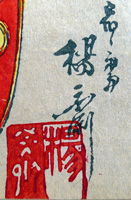 |
| Seal | Yōsai 楊斎 |
| Publication Date | #609 - unknown; - month and day of intended release of the print is given as April 1st, but year is not shown. (See publisher's seal above) #901 - April 1, 1899 |
| Publisher | Hasegawa Tsunejirō 長谷川常治郎 - see images of seals on both prints above. [Marks: pub. ref. 469] |
| Impression | #609 - good #901 - good |
| Colors | #609 - excellent #901 - excellent |
| Condition | #609 - excellent #901 - good: three panels joined and backed; trimmed to image |
| Genre | ukiyo-e; kaika-e |
| Miscellaneous | |
| Format | vertical oban triptych |
| H x W Paper | #609 - 14 1/2 x 9 5/8 in. (36.8 x 24.4 cm) each panel #901 - 14 x 27 3/4 in. (35.6 x 70.5 cm) entire triptych |
| Literature | |
| Collections This Print |


